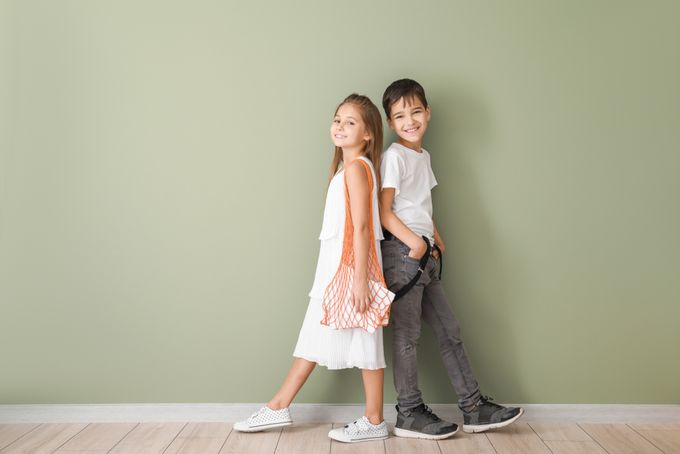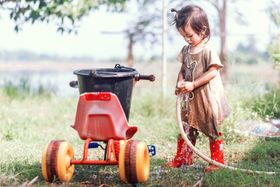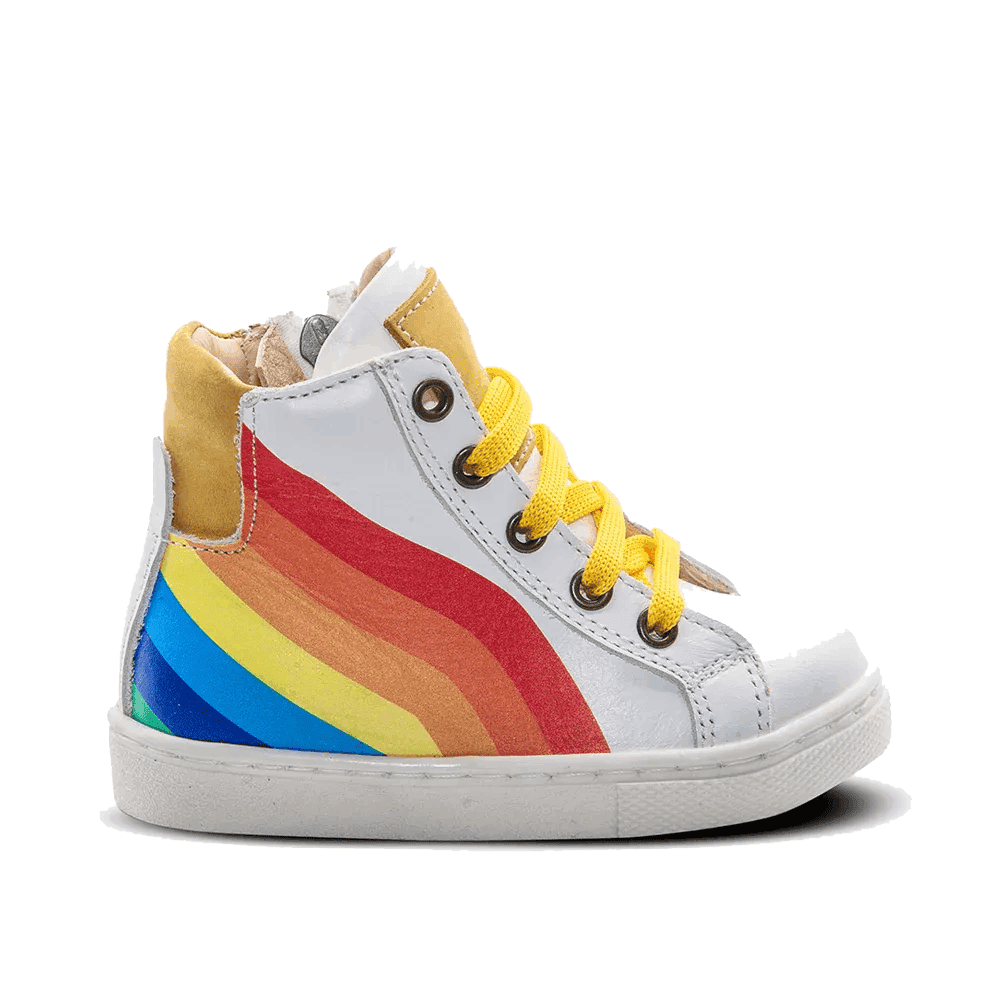Children's Shoe Sizes: Is There a Difference Between Boys' and Girls' Footwear?
Are kids' shoe sizes the same for boys and girls? The answer changes as your child grows! Our quick guide, based on podiatric principles, explains the subtle differences in width and structure and what matters most for healthy, growing feet.
Updated October 16, 2025

The question, "Are boys' and girls' shoe sizes the same?" is a common one, and the short answer is: yes, and no. For infants and first walkers, shoe sizes are typically unisex and based purely on foot length and standard width.
As children grow (starting around age 5-6), shoe manufacturers bring in slight structural differences that affect the width and arch shape as feet change with weight-bearing [1]. This is why you must measure your child's foot, not just choose by gender.
» Take a look at our collection of boys' and girls' shoes in various sizes
3 Structural Differences in Boys' and Girls' Footwear
While overall size (length) is more or less the same, there are slight but important structural variations you might notice when looking at the difference between boys' and girls' shoes:
1. Foot Width and Volume in Boys' and Girls' Footwear
Generally, the main difference between boys' and girls' shoes is the width.
Boys' shoes are mainly designed with a wider last (the mould the shoe is built around) and greater foot volume. to accommodate broader feet.
Girls' shoes may be designed with a slightly narrower width, especially through the heel and midfoot, and a lower overall volume.
Keep in mind that orthotics-friendly and podiatrist-designed shoes offer a universal, supportive arch and a firm heel counter to promote healthy alignment for every foot, regardless of gender.
2. Arch and Ankle Structure in Boys' and Girls' Footwear
Shoe manufacturers often differentiate the design of a pair of shoes for arch support and ankle collar, based on gender. Because of this, girls' shoes are sometimes designed with a slightly higher arch profile, while boys' shoes might have a flatter footbed.
However, this only applies to manufacturers' shoes. With orthotics-friendly and podiatrist-designed shoes, they offer a universal, supportive arch and a firm heel counter to promote healthy alignment for every foot, regardless of gender.
3. Heel Height and Stability in Boys' and Girls' Footwear
Heel design is another common point of difference, though this is less so in high-quality children's brands.
When it comes to generic girls' shoes, particularly in fashion styles, they might introduce a small, non-supportive heel, while boys' shoes maintain a near-flat profile.
First Walkers Brand Philosophy: Orthopedic and first walker shoes prioritise stability above all else. Our designs maintain a low, supportive heel and flexible sole, ensuring a stable platform for walking and running, regardless of whether you choose a boys' or girls' design.
The Podiatrist's Perspective on Boys' and Girls' Shoe Sizes
The most important factors for your child's footwear have nothing to do with their gender. They have everything to do with healthy foot development. If you're still wondering about whether kids' shoe sizes are the same for boys and girls, it's best to focus on the individual foot rather than gender labels.
The 3 F's on Boys' and Girls' Shoes
These three factors are the only things that truly matter for healthy foot development:
- Fit: Look for shoes that match your child's foot length and width, with about a thumb's width of growing room. Remember, foot measurements vary widely between children, regardless of whether they're boys or girls.
- Function: Your child needs shoes that actually work for their daily activities. This means a firm heel counter for stability, a deep toe box so their toes can move freely, and a non-slip sole. These aren't optional features; they're essential for young, developing feet.
- Flexibility: Check that the shoe bends at the ball of the foot (where your child's foot naturally bends when they walk) whilst staying stable through the midfoot and heel.
Why Are Our Boys' and Girls' Shoes Size and Structure Different
While we offer appealing designs for both boys and girls, the internal structure of every First Walkers shoe has the same engineered structure underneath, designed specifically for foot health.
What this means for your child:
- Firm Heel Counter: Secures the ankle and prevents excessive rolling, which is particularly important for children with low muscle tone or overpronation.
- Arch Support: Provides gentle, in-built support to guide flat feet as they develop, rather than leaving them unsupported.
- Deep Toe Box: Allows natural toe splay, which is essential for balance and healthy foot development.
These features don't change based on whether you choose a boys' or girls' design. That's because growing feet have the same fundamental needs, regardless of gender.
Measure Your Child's Feet for Their Shoe Size
The most important step in choosing footwear is accurate measurement and choosing the right shoe size. Children's feet grow quickly, especially during growth spurts, so measure every 2-3 months to ensure proper fit.
Use our easy-to-follow shoe-measuring guide to find the correct length and width for your child's growing feet. Once you know their measurements, you can confidently choose either a boys' or girls' design with the accurate size.
What sets First Walkers apart is our focus on what paediatric specialists know matters most, proper orthopaedic support during critical development years.
Our shoes combine medical-grade structure (firm heel counters, arch support, and deep toe boxes) with designs children actually want to wear, so you don't have to choose between foot health and your child's happiness.
References
Change of foot size with weightbearing. A study of 2829 children 3 to 18 years of age. (1997, September 1). PubMed. https://pubmed.ncbi.nlm.nih.gov/9308534/
Disclaimer: First Walkers' information is intended for educational and informational purposes related to toddler footwear and feet. We encourage you to consider individual circumstances and consult qualified orthopaedists about specific conditions.
FAQs
Should I buy my daughter boys' shoes if she has wide feet?
Absolutely. If your daughter has wider feet, boys' shoes may provide a better fit. The most important factor is finding shoes that accommodate your child's actual foot shape rather than adhering to gender labels. At First Walkers, we also offer wide-fit options that work for any child, regardless of gender.
At what age do boys' and girls' shoe sizes start to differ?
Shoe manufacturers typically begin introducing structural differences around ages 5-6. Before this age (particularly for infants and first walkers), shoe sizes are usually unisex. However, every child develops differently, so it's essential to measure your child's feet regularly and choose shoes based on their individual measurements.
How often should I measure my child's feet?
You should measure your child's feet every 2-3 months during periods of rapid growth (typically ages 1-3) and every 3-4 months for older children. Growth spurts can happen quickly, and shoes that fit well one month may become too tight the next. Proper fit is crucial for healthy foot development.
Related Articles

How to Wash Different Types of Kids' Shoes
Bhashwati Deb Barma
December 6, 2024

6 Best Waterproof Shoes for Kids: Top Picks for Rainy Days
Jasrah Javed
May 9, 2024

Online Shoe Shopping Guide for Kids: Finding the Perfect Fit
George Croft
June 13, 2024

Clarks Kids' Shoes Alternatives: Top 3 Stylish and Durable Options
Jasrah Javed
March 27, 2025

How to Trim Your Toddler's Nails Without the Tantrum
Jasrah Javed
February 3, 2025
